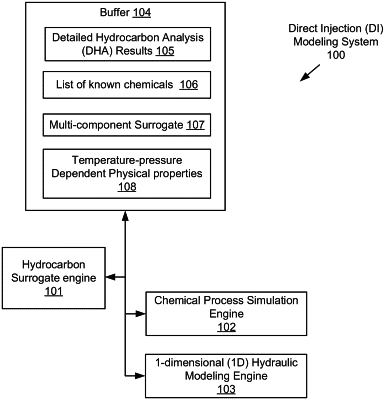| CPC G16C 60/00 (2019.02) [G01N 33/2852 (2013.01); G16C 20/30 (2019.02); G16C 20/40 (2019.02)] | 20 Claims |

|
1. A method to improve performance of an internal combustion engine, the method comprising:
determining, based on a detailed hydrocarbon analysis, a plurality of components of a physical fuel sample;
selecting, by a computer processor and for a first hydrocarbon of the plurality of hydrocarbons, a first plurality of chemicals from a list of known chemicals in a chemical property database, chemical property correlation software, or chemical process software package, the first hydrocarbon having a first equivalent molecular structure as each of the first plurality of chemicals;
dividing, by the computer processor, a first concentration of the first hydrocarbon in the physical fuel sample into a first plurality of surrogate concentrations corresponding to the first plurality of chemicals;
generating, by the computer processor, a multi-component surrogate based at least on the first plurality of surrogate concentrations, wherein each of the first plurality of chemicals represents the first hydrocarbon as a surrogate in the multi-component surrogate;
generating, by using the multi-component surrogate to represent the physical fuel sample in a one-dimensional (1D) hydraulic modeling software, modelling results of a direct injection (DI) system of the internal combustion engine, the modeling results comprising calculated interaction between the physical fuel sample and mechanical components in the DI system; and
refining, based on the modelling results, structural features of the mechanical components in the DI system to improve the performance of the internal combustion engine,
wherein the refining comprises:
assessing efficacy of hardware design changes of the mechanical components in said improving the performance of the internal combustion engine; and
performing an experiment where an amount of the physical fuel sample is dispensed using an actual physical injector to obtain an experimental performance measurement,
wherein the experimental performance measurement substantially matches a modeled performance measurement in the modeling results.
|